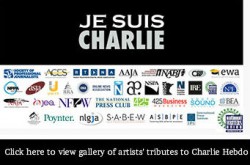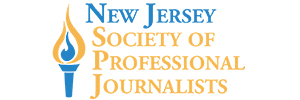 Editor’s note: Please join us Thursday Feb. 12 from 7-9 p.m. for Courage Under Fire, a forum on free speech at home and abroad. The event, at the NJ Historical Society, 52 Park Pl., Newark, is free. To register, click here.
Editor’s note: Please join us Thursday Feb. 12 from 7-9 p.m. for Courage Under Fire, a forum on free speech at home and abroad. The event, at the NJ Historical Society, 52 Park Pl., Newark, is free. To register, click here.
When terrorists murdered 12 people at the French satirical magazine Charlie Hebdo and then killed four Jews at a kosher supermarket shortly thereafter, it was an attempt to trounce the ideals underpinning every free society.
The murders are a reminder that we must guard the rights of all of us to state our beliefs, and that we must also be informed about the dangers of ideologies that regard dissent as a danger to be plucked out like a weed.
What made the Charlie Hebdo staff so brave is that they continued to exercise their right to free expression (which, in their case, also involved offending some people) despite the very real threats against their lives. What made their killings so repugnant is that the terrorists responded to the magazine’s right to free expression with murder.
That cannot be ignored, and that is why we, as journalists, stand by the editors of Charlie Hebdo and the values they represent. To quote The New York Times columnist Ross Douthat: “When offenses are policed by murder, that’s when we need more of them, not less, because murderers cannot be allowed for a single moment to think their strategy can succeed.’’
What is Charlie Hebdo?
There is no equivalent to Charlie Hebdo in the United States or Canada. The predecessor magazine to Charlie Hebdo was Hara Kiri, founded in 1970. It was closed by the French government for an inappropriately timed satirical pun about the death of Charles DeGaulle.
That publication was reopened as Charlie Hebdo, the “Charlie” being for Charlie Brown. It published cartoons depicting the Muslim prophet Muhammad, which is offensive to many Muslims, but it was also an equal-opportunity offender: it published a cartoon of a dog having sex with the French President Hollande and a cartoon of the Virgin Mary with the nose of a pig.
Did those cartoons offend people?
Of course.
That is why the re-publication of the cartoons provoked so much debate within newsrooms in this country.
At the heart of the issue was where to draw the line between free expression, newsworthiness and sensitivity to people who could be deeply offended by the publications of the depictions of the prophet Mohammed. That’s a fair question, and one that we, too, debated within our membership, only to discover there is no consensus.
Free speech is complicated
If there’s one good to come out of the Charlie Hebdo attacks, it is that it has drawn attention to the issue of free speech and just how complicated it can be. While free speech is the bedrock of a free and democratic society because it allows for the free exchange of ideas, it is not an absolute: you can’t yell fire in a crowded theater – unless there really is a fire.
In fact, we are always debating where to draw the line: Should hate speech on the internet be protected? Should a professor have the right to make anti-gay remarks in his or her classroom? What about producing an opera that some, including the Anti-Defamation League, fear might be used to spread anti-Semitism?
Similar issues play out in newsrooms all the time as we make ethical choices about how to handle a story and seek to find the balance between newsworthiness and sensitivity to our readers. Sometimes news value trumps sensitivity such as when we publish stories about pedophile priests.
And sometimes the decision is to exercise restraint: we don’t publish the names of rape victims; we refrain from showing the child pornography that was captured in a raid; we don’t show the gruesome videos of the journalists who were beheaded by ISIS. These ethical choices go beyond strict legal boundaries. (BTW: For a good overview of First Amendment law, take the Student Press Law Center’s First Amendment quiz. Not only does it test your knowledge, it references the court cases that helped establish case law. You can find it here.)
The historical roots of free speech
As journalists, we are guided by our belief in a free marketplace of ideas.
In doing so, we take our inspiration from the French Enlightenment thinker Voltaire, aka Francois Marie Arouet. His ideas about freedom of expression, freedom of religion and separation of church and state helped give birth to the ideas that are enshrined in the Bill of Rights.
In 1736, before Voltaire served a term of 11 months in the Bastille, and subsequently adopted his mother’s maiden name, he penned A Treatise on Metaphysics in which he wrote: “Virtue and vice, moral good and evil, are…whatever is useful or harmful to society.” And in a letter, he wrote, “All societies…will not have the same laws, but no society will be without laws. Therefore, the good of the greatest number is the immutable law of virtue.”
The idea of acting for the greater good of society is a common ethical concept and one popularized later by John Stuart Mill in England. Further, in another book in 1763, A Treatise on Toleration, Voltaire wrote: “The supposed right of intolerance is absurd and barbaric. It is the right of the tiger; nay it is far worse, for tigers do but tear in order to have food, while we rend each other for paragraphs.” In today’s world, that pertains to images as well.
What Voltaire teaches us is that you have to look at both the intellectual and emotional sides of an issue to determine a course of action that meets society’s needs. You have to set aside personal feelings and reactions to the ethical problem and analyze it carefully. Your solution should serve others, not yourself. So he advocates balance between the emotions and the intellect. As the quote attributed to Voltaire goes: “I disapprove of what you say, but I will defend to the death your right to say it,” which implies the strength of his philosophy in an open, free society. (By the way: this quote was misattributed to Voltaire; the quote was really used for the first time by Evelyn Beatrice Hall, writing under a genderless nom de plume, in a 1906 book, The Friends of Voltaire, as a summary statement of his beliefs.)
This leads to an important corollary: we believe that the way to fight hate speech is with more speech. The idea here is that speech can illuminate the haters and shine a light on their anger. It may not end the hate, but it can uncover it and bring it to the attention of the public.
It’s not just Charlie Hebdo
So let us now turn to the present.
On, January 7th, the same day that the four people were killed in the kosher supermarket in Paris, satellite images revealed that more than 2,000 Nigerians were killed by Boko Haram, which not only attacks free speech but also open education.
Journalists are also targets of those who have no respect for the free exchange of ideas.
According to the Committee to Protect Journalists, 734 journalists have been murdered since 1992, and the rate went up last year, especially in the Middle East. China, the worst jailer of journalists, has more than 200 imprisoned, with a sharp rise in the last three years. Other members of the press are exiled or have disappeared.
These attacks, including those against Charlie Hebdo, are a clarion call to protect free speech. That is why we must all use our talents to express our revulsion and put those issues on the public agenda.


Be the first to comment on "Why “We are Charlie”. . . and an invitation to our Feb. 12 forum on free speech"